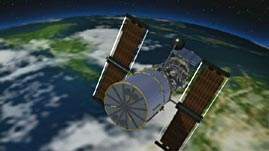Teachers' Domain - Digital Media for the Classroom and Professional Development
User: Preview

Source: Produced for Teachers' Domain
Astronomer Edwin Hubble determined two things that shook the foundations of astronomy: billions of galaxies exist outside of our own, each of which contains billions of stars, and the universe is actually expanding. This adapted video segment uses footage from NOVA and NASA to show how Hubble's findings laid the foundation for the Big Bang theory.
Before 1919, most scientists held that the universe was only as large as the Milky Way and that it was a constant size. Then, in 1919, the American astronomer Edwin Hubble — aided by a technologically advanced 100-inch telescope — was able to discern individual stars within what he believed to be a nebula, a fuzzy cloud of light composed of cosmic gases. After calculating that the distance to these stars from Earth was much further than the known reaches of the Milky Way, he concluded that the stars were part of a galaxy separate from our own. The idea that our galaxy was just one of many galaxies changed forever the way we view our place in the universe.
To measure distance, Hubble used Cepheid variable stars as reference points. Cepheids are young, bright, massive stars that pulsate, regularly changing their luminosity. The time it takes for one complete pulsation is called its period. Several years earlier, Henrietta Leavitt, another American astronomer, had established that the brighter a Cepheid appeared as seen from Earth, the longer its period was, and that by measuring the period, one could determine its luminosity, or absolute brightness. Drawing on Leavitt's work, Hubble compared the apparent brightness of a Cepheid with its luminosity to determine its distance from Earth. Hubble's method worked because all Cepheids with the same periods have about the same luminosity, and if a star's luminosity is known, its distance can be determined by its apparent brightness.
The spectra of light emitted by celestial bodies shift depending upon whether the bodies are moving toward Earth or away from it. A change in the wavelength and frequency of light is perceived as a change in color. For galaxies moving toward Earth, the shift is toward the blue end of the spectrum; for galaxies moving away, the light they emit appears redder. By observing redshifts in the light wavelengths emitted by the galaxies, Hubble saw that galaxies were moving away from each other at a rate constant to the distance between them. He determined that the greater the distance between a galaxy and Earth, the faster that galaxy was moving away from us — a phenomenon now known as Hubble's law. These findings signaled that the universe is expanding and laid the foundations for the Big Bang theory, which states that the universe exploded into existence from a single point or a very small region in time and space and has been expanding ever since.
To honor Hubble for his contributions to the field of astronomy, in 1989 NASA named the Hubble Space Telescope after him. Images seen from this telescope are incredibly clear because the telescope views space from outside Earth's atmosphere. There, it is free of the distortion and filtering of light that happens when the light passes through the atmosphere, which it must when space is viewed from Earth. These images provide scientists with information critical to determining with greater accuracy not only the age of the universe, but also its size and expansion rate.
 Loading Standards
Loading Standards Teachers' Domain is proud to be a Pathways portal to the National Science Digital Library.
Teachers' Domain is proud to be a Pathways portal to the National Science Digital Library.
